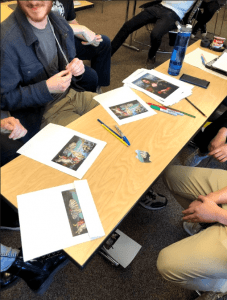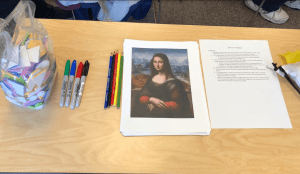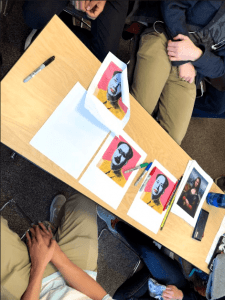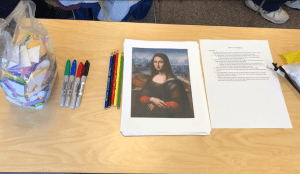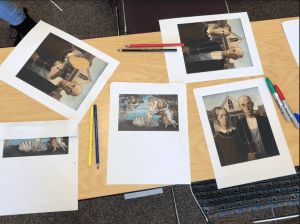Appropriation Game: THE SHIP OF THESEUS
Gameplay:
- A Judge is picked for the round. For the first round, the oldest player is made Judge. After the first round, the winner of the previous round becomes the Judge
- The Judge selects one of the groups of pictures and passes them out to players.
- All of the pictures are separated into groups based on what they represent. There’s four copies of the Mona Lisa, Four copies of the Birth of Venus, etc.
- Players are given one minute to transform their image the most while alternating their image the least (The most change with the least effort)
- Players can use the tools provided (Colored Pencils, Colored Markers, Felt Stickers), as well as whatever tools they also have (Pens, Scissors, Glue, etc.)
- Players can also alter the image physically (rip, fold, etc.)
- Once the minute is up, players present their transformations to the Judge
- The Judge goes through them all and determines which one they think best meets the criteria
- The Judge selects a winner, and returns their transformed image to them. The other transformed images are placed in a discard pile. The winner then becomes the next Judge, and the next round starts.
- After all of the pictures have been transformed, players see how many rounds they have won by counting through all of the transformed images they had returned to them. The player with the most won rounds wins the game.
Artist Statement:
The Ship of Theseus is a party game in the style of Apples to Apples in which three players are tasked with transforming pictures of famous paintings the most, while also doing the least amount of work or effort to transform said image. A judge then picks the piece with they think best meets the criteria, and the player with the most rounds won wins the game.
The Ship of Theseus is less a game with appropriated elements and more a game about appropriation, asking questions like “When does something become art?”, and, more specifically to this game, “when does one piece of art become another piece of art?” To a lesser extent, the game is also a critique of the legal processes that affect the art world, because in the end, the guidelines for rulings are vague, and it’s up to a judge to make the final decision.
The two major inspirations for the game are 1.) Richard Prince and his body of work, and 2.)The Ship of Theseus Paradox, the game’s namesake. The Ship of Theseus Paradox is a metaphysical thought experiment which goes as follows:
The hero Theseus sails his ship into battle, and afterwards it is placed in a museum in the city of Athens as a memorial. After many years, the boards on the ship begin to rot, and one by one the boards are replaced until, finally, none of the original boards remain. Is the ship that’s in the museum now the same ship that entered? If not, when did it change?
This conundrum of identity also affects the work of Richard Prince, whose entire career has been based on the grey zone between altering an existing piece of art and creating an entirely new piece of art. Prince’s 2008 series Canal Zone, and the subsequent legal battle between Prince and the photographer whose work he appropriated, was the main inspiration for the goal of the game.
The images that players appropriate in The Ship of Theseus also draw inspiration from other famous appropriation artists, such as Marcel Duchamp (specifically L.H.O.O.Q., 1919) and Andy Warhol (Mao 91, 1972). On top of that, some of the other art featured (Mona Lisa, The Sistine Chapel, The Birth of Venus) was chosen because, on top of them being famous, they are the kinds of work that the Dada movement was responding to.
Documentation:
